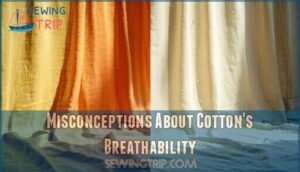This site is supported by our readers. We may earn a commission, at no cost to you, if you purchase through links.

You’ll stay cooler in linen than most other fabrics because its hollow flax fibers create natural air channels that allow heat to escape while letting cool air circulate.
The loose weave structure acts like tiny ventilation systems throughout the fabric.
Linen absorbs up to 20% of its weight in moisture without feeling damp, then quickly wicks that sweat away from your skin.
This combination of airflow and moisture management makes linen superior to cotton for breathability, especially in humid conditions where you need that extra cooling power.
Table Of Contents
- Key Takeaways
- Benefits of Linen’s Breathability
- Comparison of Natural and Synthetic Fabrics
- How Does Linen Compare to Cotton in Breathability?
- The Unique Qualities of Linen
- Why Linen is The Ideal Fabric for Summer
- How to Care for Linen to Maintain Its Breathability
- Other Considerations for Linen’s Breathability
- The Versatility of Linen in Fashion
- Frequently Asked Questions (FAQs)
- Conclusion
Key Takeaways
- You’ll experience superior cooling because linen’s hollow flax fibers create natural air channels that allow heat to escape while promoting continuous airflow against your skin.
- You can stay dry in humid conditions since linen absorbs up to 20% of its weight in moisture without feeling damp and wicks sweat away faster than cotton.
- You’ll find linen outperforms cotton significantly in breathability due to its looser weave structure and superior heat conductivity that transfers body heat away more efficiently.
- You can maintain linen’s breathability long-term by washing it in cold water, air-drying when possible, and avoiding fabric softeners that can clog the natural fiber structure.
Benefits of Linen’s Breathability
You’ll discover that linen’s breathability offers four key advantages that make it perfect for hot weather and active lifestyles.
These benefits work together to keep you comfortable, dry, and cool while ensuring your fabric investment lasts for years.
Moisture Wicking
When you’re sweating on a hot day, linen fabric’s hydrophilic properties work like a personal cooling system.
Thanks to superior linen absorption, this breathable fabric can soak up 20% of its weight in moisture without feeling damp.
The magic happens through efficient sweat evaporation—linen pulls perspiration away from your skin and releases it quickly into the air.
This moisture wicking process keeps you comfortable even in sticky humidity, while also preventing bacterial growth that thrives in damp conditions.
Cooling
Linen’s cooling properties work like nature’s air conditioning system.
The fabric’s high heat conductivity rapidly transfers body heat away from your skin, while its loose weave creates natural ventilation channels.
This evaporative cooling effect maintains your personal microclimate, delivering superior summer comfort that synthetic cooling fabrics simply can’t match.
Quick Drying
After keeping you cool, linen fabric’s quick-drying properties guarantee you stay comfortable longer.
The fiber composition and weave density create excellent evaporation rates, even in high humidity conditions.
Moisture wicking pulls sweat away fast, while the breathable structure releases it rapidly.
Whether air-dried or machine-dried, this quick-drying fabric outperforms cotton substantially, making linen properties ideal for active days.
Durability
Beyond quick-drying benefits, linen’s fiber strength makes it incredibly durable for breathable fabrics.
The flax fibers are naturally stronger than cotton, with superior abrasion resistance that withstands regular washing and wear.
This weave density creates linen fabric that maintains its breathable properties through long-term use, making durability a key advantage.
Proper care impact guarantees your linen properties stay intact for years, ensuring the long-term use of the fabric.
Comparison of Natural and Synthetic Fabrics
When choosing fabrics for hot weather, you’ll find that natural and synthetic materials offer different advantages for breathability and comfort.
Natural fabrics like linen and cotton excel at air circulation, while synthetic options provide durability and moisture-wicking technology that keeps you dry during active wear.
Breathability of Natural Fabrics
Natural fibers consistently outperform synthetic materials in terms of fabric breathability.
Natural fibers breathe better than synthetics—your skin will thank you
While your cotton t-shirt might feel comfortable, linen fabric takes air circulation to another level through its unique fiber density and fabric weaves.
| Fabric Type | Breathability Rating |
|---|---|
| Linen | High |
| Cotton | Moderate |
| Polyester | Low |
Natural fibers like linen create superior airflow patterns compared to their synthetic counterparts.
The loose weave structure in breathable fabrics allows air to move freely, while synthetic materials often trap heat against your skin.
This difference becomes particularly noticeable in humid conditions where moisture retention affects comfort.
Linen breathability stems from its hollow flax fibers that prevent heat buildup.
Considering linen’s moisture-wicking capabilities, it’s an ideal choice for hot and humid climates.
The climate impact of choosing natural fibers extends beyond personal comfort—you’re also supporting ethical sourcing practices that benefit both workers and the environment.
Benefits of Synthetic Fabrics
While synthetic fabrics don’t match linen’s natural breathability, they pack their own punch in performance features.
You’ll find that synthetic materials excel in specific areas where natural fibers sometimes fall short.
Synthetic Durability stands out as a major advantage.
These fabrics resist tearing, stretching, and general wear better than most natural options.
Stain Resistance means spills won’t ruin your day, while Wrinkle Resistance keeps you looking sharp without constant ironing.
Cost Effectiveness makes synthetics budget-friendly, especially for active wear.
Stretch Fabrics move with your body during workouts or busy days.
Many synthetic fabrics offer excellent moisture wicking properties, pulling sweat away from skin efficiently.
| Performance Features | Practical Benefits |
|---|---|
| Moisture-wicking technology | Keeps skin dry during activity |
| Wrinkle-resistant fibers | Low-maintenance care routine |
| Durable construction | Long-lasting wear value |
Though synthetic fabrics may not provide the same natural breathable fabric experience as linen, they deliver reliable performance when durability and functionality matter most.
How Does Linen Compare to Cotton in Breathability?
You’ll find that linen consistently outperforms cotton in terms of breathability, thanks to its unique fiber structure and looser weave patterns.
While cotton’s often marketed as a breathable fabric, it actually retains moisture longer and provides less airflow than linen’s naturally ventilated construction, making linen a better choice in terms of airflow.
Linen’s Superior Breathability
How exactly does linen achieve its legendary cooling reputation? The answer lies in its remarkable Fiber Structure and sophisticated moisture management system that outperforms cotton in every measurable way.
Linen’s hollow flax fibers create natural air channels that cotton’s solid fibers simply can’t match. This unique structure delivers superior airflow through your clothing, making linen the ultimate breathable fabric.
The loose Weave Impact creates tiny gaps between threads, allowing warm air to escape while cool air circulates freely against your skin.
Here’s where linen truly shines compared to cotton:
- Moisture Absorption reaches 20% of fabric weight without feeling damp
- Heat Conductivity rapidly transfers body heat away from skin
- Hollow fiber structure prevents fabric from clinging to your body
- Quick-drying properties maintain comfort throughout the day
- Comfort Factors include natural temperature regulation and reduced stickiness
While cotton absorbs moisture well, it retains heat and dries slower than linen. This makes linen the clear winner for hot weather comfort, offering linen benefits that keep you cool when temperatures soar.
Linen also boasts naturally antibacterial properties, further enhancing its appeal for sensitive skin.
Misconceptions About Cotton’s Breathability
Cotton myths often mislead people about breathability comparisons. Many assume cotton equals comfort, but this comfort illusion masks important differences.
When examining linen vs cotton, weave matters substantially – cotton’s tighter construction restricts airflow compared to linen’s open structure. Fiber density also plays a vital role; cotton fibers pack more densely, limiting ventilation.
Cotton’s moisture retention becomes problematic in humid conditions, while linen excels at releasing dampness quickly. Though cotton feels soft initially, it can’t match linen’s superior breathability and cooling properties.
Linen’s advantage stems from its hollow fiber structure, promoting airflow. Understanding these distinctions helps you choose the right breathable fabric for hot weather comfort.
The Unique Qualities of Linen
Linen offers unique advantages that make it perfect for warm weather comfort and travel convenience.
Its lightweight construction and natural cooling properties create an ideal combination for staying comfortable while looking effortlessly put-together.
Lightweight and Compact
Beyond breathability, linen fabric offers remarkable practical advantages that make it perfect for your minimalist wardrobe. You’ll appreciate how this breathable fabric packs effortlessly into your suitcase without creating bulk or adding weight to your luggage.
Linen’s compact nature makes it incredibly travel friendly, allowing you to pack multiple pieces in the space traditionally required for just one cotton garment. This space saving quality proves invaluable for quick trips where every inch of packing space counts.
The fabric’s lightweight construction doesn’t sacrifice durability, giving you:
- Effortless packing that reduces luggage weight by up to 30%
- Wrinkle resistance that eliminates the need for bulky garment bags
- Quick-drying properties perfect for wash-and-wear travel scenarios
- Versatile pieces that shift seamlessly from day to evening
- Compact storage that maximizes closet space at home
This packing ease makes linen summer clothing an essential choice for travelers who value both comfort and convenience in their wardrobe selections.
Natural Cooling Properties
Linen’s natural cooling properties stem from its unique fiber structure and exceptional heat conductivity.
When you wear linen, the hollow flax fibers create channels that promote weave airflow, allowing heat to escape rather than trap against your skin.
The fabric’s superior moisture absorption capabilities pull sweat away from your body, while its loose weave enhances breathability through continuous air circulation.
Unlike synthetic materials, linen’s natural fibers provide thermal insulation that adapts to your body’s needs.
This cooling effect becomes most noticeable in hot, humid conditions where linen outperforms cotton and other fabrics in maintaining comfortable temperatures.
Linen’s durability also means it can last for decades, unlike cotton’s shorter lifespan.
Why Linen is The Ideal Fabric for Summer
When summer heat becomes unbearable, linen transforms into your personal cooling system that works around the clock.
You’ll stay comfortable in sweltering weather while enjoying the convenience of a fabric that packs light and travels effortlessly, making it a great companion for summer travels with its ability to keep you cool.
Stay Cool and Comfortable
In hot summer weather, linen becomes your best friend for staying cool and comfortable.
The fabric’s exceptional breathability creates natural airflow that prevents overheating, while its moisture-wicking properties keep your skin dry even during active wear sessions.
When you choose linen for summer outfits, you’re investing in superior heat management that synthetic fabrics simply can’t match.
The cooling effect occurs because linen’s loose weave allows air to circulate freely against your skin, promoting better skin health by reducing moisture buildup.
Whether you’re exercising or simply enjoying outdoor activities, linen comfort remains consistent throughout the day, making it the smart choice for anyone prioritizing both style and temperature regulation.
Easy to Pack and Travel With
You’ll appreciate linen’s travel-friendly nature when you’re rushing to catch your next flight.
This lightweight fabric won’t weigh down your suitcase, and its natural wrinkle resistance means you can fold or roll garments without stress.
Linen clothing bounces back from tight packing, maintaining its shape and breathability even after hours cramped in overhead compartments.
The space saving benefits are remarkable – you’ll fit more summer clothing into smaller luggage while keeping your travel wardrobe versatile.
Whether you’re exploring humid cities or relaxing on beaches, linen’s comfortable fabrics adapt to any destination, making packing techniques simple and efficient.
How to Care for Linen to Maintain Its Breathability
You’ll want to wash linen properly to preserve its natural breathability and cooling properties. Gentle care techniques guarantee your linen garments continue wicking moisture and allowing airflow season after season.
Proper Washing and Drying Techniques
When caring for linen clothing, following proper washing temperatures and drying methods preserves the fabric’s natural breathability. Your linen garments deserve gentle treatment to maintain their moisture-wicking abilities and cooling properties.
Here’s your essential linen care routine:
- Wash separately in cold water – Hot washing temperatures cause shrinkage and damage delicate fibers
- Choose mild detergent – Avoid fabric softeners that coat fibers and reduce absorbency
- Air dry when possible – Line drying maintains fiber structure better than machine heat
- Use low heat if machine drying – Remove while slightly damp to prevent stiffness
These storage solutions and fabric properties work together. High heat can cause linen fiber relaxation, permanently altering the dimensions of the garment. Proper linen care prevents the fiber damage that compromises breathability, ensuring your linen fabric stays cool and comfortable season after season.
Ironing and Storing Tips
After proper washing and drying, effective ironing techniques and storage methods become essential for linen longevity.
When ironing linen fabric, use medium heat with steam to prevent damage while smoothing wrinkles. High heat can weaken linen’s natural fiber structure, reducing its breathability over time.
For wrinkle prevention, iron while slightly damp or use a spray bottle.
Storage methods matter equally – hang linen clothing in breathable garment bags or fold loosely in drawers with cedar blocks. Consider using specialized bags for storage to protect your garments.
| Ironing Guidelines | Storage Best Practices |
|---|---|
| Medium heat with steam | Breathable garment bags |
| Iron when slightly damp | Cedar blocks for freshness |
| Avoid high direct heat | Clean before storing |
Proper linen care preserves fabric properties and helps your garments maintain their natural cooling abilities season after season.
Other Considerations for Linen’s Breathability
While linen’s breathability shines in hot weather, you’ll want to keep in mind how it performs in air-conditioned spaces.
The fabric’s cooling properties can feel too cool in heavily air-conditioned environments, and new linen may feel stiff and wrinkle easily until it softens with wear and washing.
Linen in Air-Conditioned Environments
Linen fabric performs exceptionally well in air-conditioned environments, offering unique advantages for AC Comfort.
The breathable structure maintains prime airflow even in cooled spaces, preventing that stuffy feeling common with synthetic materials.
Linen’s superior Humidity Impact management absorbs excess moisture from your skin while releasing it efficiently into conditioned air, creating better fabric ventilation than cotton alternatives.
For effective Layering Strategies, you’ll find linen’s lightweight nature perfect for temperature shifts between outdoor heat and indoor cooling.
The Fiber Performance excels at regulating your body’s microclimate, preventing overheating when moving between environments.
This natural temperature control contributes to Energy Savings by reducing your need to adjust thermostats frequently.
Linen breathability ensures consistent comfort whether you’re in blazing sunshine or chilled office spaces, making it your reliable companion for modern living.
Its open weave construction provides excellent airflow.
Initial Texture and Wrinkling
First-time linen wearers often encounter the fabric’s characteristic stiffness and wrinkle-prone nature, but these initial traits shouldn’t deter you from experiencing linen’s superior breathability.
The New Linen Feel includes a slightly rough texture that transforms beautifully over time, becoming softer with each wash and wear.
Consider these softening techniques to enhance your linen clothing experience:
- Pre-wash benefits include removing manufacturing residues and beginning the natural softening process
- Blending impact occurs when linen-cotton combinations reduce initial stiffness while maintaining breathability
- Wrinkle resistance improves through proper care, though many embrace linen fabric’s relaxed, lived-in appearance as part of its natural charm
The Versatility of Linen in Fashion
Linen’s breathability makes it perfect for creating versatile outfits that work in various settings.
You can easily dress linen up for smart casual occasions or keep it relaxed for everyday comfort.
Linen for Relaxed and Smart Casual Looks
Beyond air-conditioned environments and texture concerns, linen’s breathable fabric shines in fashion applications.
You can effortlessly create polished looks with linen separates that work from morning coffee to evening events. Casual tailoring becomes simple when you choose breathable linen clothing that maintains structure without sacrificing comfort.
Summer outfits benefit from linen’s natural cooling properties, whether you’re wearing a crisp shirt or flowing dress. Layering linen pieces adds depth to your wardrobe while preserving breathability.
Accessorizing linen with belts or jewelry enhances summer fashion without compromising the fabric’s temperature-regulating benefits. Linen is ideal for creating linen casual looks that exude effortless style and comfort.
Pairing Linen With Different Bottoms
How can you transform your linen tops into versatile outfits that work for every occasion? The secret lies in choosing the right bottoms that complement linen fabric’s natural breathability and comfort.
Linen Shorts create the ultimate summer combination, allowing maximum airflow while maintaining style. Whether you’re wearing denim cutoffs or styled Bermuda styles, this pairing keeps you cool during hot afternoons.
Linen Skirts offer feminine elegance – from flowing midi styles to structured A-lines, they enhance linen’s natural drape while promoting air circulation.
For sophisticated looks, try Wide Leg trousers or Flowy Pants that mirror linen’s relaxed aesthetic. These bottoms won’t compete with your breathable linen clothing for attention.
Culottes provide a modern middle ground between pants and skirts, perfect for office settings where you need professional appearance with cooling comfort.
- Mix textures strategically: Combine structured bottoms with flowing linen tops to create visual interest while maintaining the natural fibers’ breathability benefits.
The key is understanding how different bottom styles complement linen’s unique properties, ensuring you stay comfortable while looking polished. When selecting linen clothing, consider the linen shorts options to find the perfect match for your tops.
Frequently Asked Questions (FAQs)
Is linen a breathable fabric?
Yes, you’ll find linen exceptionally breathable thanks to its hollow flax fibers and loose weave structure. It absorbs moisture without feeling damp and allows excellent airflow, keeping you cool.
Why is linen breathable?
What makes linen nature’s cooling champion?
You’ll find linen’s breathability comes from its hollow flax fibers that create natural air channels, loose weave allowing continuous airflow, and superior moisture-wicking properties.
That absorb sweat without feeling damp, due to its moisture-wicking properties, is a key aspect of linen’s natural cooling ability.
Why is linen considered a good fabric?
You’ll love linen’s natural durability, superior moisture-wicking properties, and exceptional breathability. It’s stronger than cotton, dries quickly, and stays comfortable in hot weather while remaining sustainable and biodegradable.
How do you Keep linen breathable?
Picture crisp morning air flowing through lightweight fabric—that’s linen’s natural state.
You’ll preserve this breathability by washing in cool water, air-drying flat, and storing loosely.
Avoid fabric softeners that clog fibers, as they can compromise the breathability of the linen.
What are the properties of linen fabric?
Linen fabric offers exceptional breathability through its hollow flax fibers and loose weave structure.
You’ll experience superior moisture-wicking that absorbs 20% of fabric weight without dampness, quick-drying properties, and natural heat conductivity for cooling comfort.
Does linen help keep you cool?
Yes, linen absolutely keeps you cool through its unique fiber structure and moisture-wicking properties.
The hollow flax fibers create natural air channels while the loose weave promotes airflow, helping regulate your body temperature effectively, which is a result of its natural ability.
Can linen fabric be too breathable in certain environments?
While linen’s breathability excels in hot climates, it can feel too airy in cold, windy conditions.
You might experience chills or drafts since linen doesn’t provide much insulation against cool air, which can be a significant drawback in cold climates.
Does linen fabric retain odors more than other fabrics?
Like a sponge that releases what it holds, linen’s breathable structure actually resists odor retention better than cotton.
You’ll find its moisture-wicking properties and quick-drying nature prevent bacteria buildup that causes smells, making it a good choice due to its ability to resist bacteria buildup.
Can linen fabric be used for athletic or sports clothing?
Athletic gear benefits from linen’s moisture-wicking properties and breathability.
But you’ll find it’s better for low-intensity activities like yoga or casual sports rather than high-impact workouts where you need stretch and durability.
Does linen breathability vary by thread count?
Just like picking the perfect thread for a needle, thread count does affect linen’s breathability.
Higher thread counts create denser weaves that reduce airflow, while lower counts maintain linen’s natural ventilation properties for ideal cooling.
Conclusion
Imagine stepping outside on a sweltering summer day – your skin immediately feels the oppressive heat clinging to you.
Now picture yourself wearing linen, where that same heat seems to flow right through the fabric instead of trapping against your body.
So yes, is linen breathable? Absolutely, and it’s your best choice for staying cool when temperatures rise.
The hollow flax fibers naturally channel airflow while the loose weave creates ventilation throughout the fabric, making linen substantially more breathable than cotton or synthetic alternatives, due to its ability to provide ventilation.
- https://www.siennaliving.com.au/blogs/journal/the-science-behind-breathable-fabrics-and-sleep
- https://www.rei.com/learn/expert-advice/how-to-pick-the-most-breathable-fabrics.html
- https://news.gatech.edu/news/2024/07/02/stay-cool-top-fabrics-wear-survive-summer-heat
- https://lemoor.co.uk/blogs/about-linen-fabric/linen-fabric-properties
- https://www.bhlinen.com/blogs/bh-linen-journal/your-ultimate-linen-fabric-faq-guide















